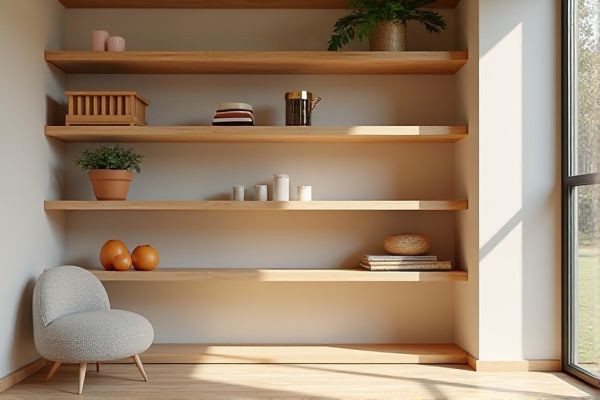
MDF pantry shelves offer a smooth surface and cost-effective option but may lack the durability and moisture resistance of plywood pantry shelves, which provide greater strength and longevity for heavy or humid storage environments. Explore the full article to discover which material best fits your pantry needs and ensures lasting performance for your home organization.
Table of Comparison
| Feature | MDF Pantry Shelves | Plywood Pantry Shelves |
|---|---|---|
| Material Composition | Engineered wood made from wood fibers and resin | Layered wood veneers bonded with adhesive |
| Durability | Moderate; prone to swelling with moisture | High; more resistant to moisture and warping |
| Weight Capacity | Lower; less structural strength | Higher; supports heavier loads |
| Cost | Generally cheaper | More expensive |
| Finish | Smooth surface, easy to paint | Natural wood grain, can be stained or painted |
| Environmental Impact | Uses recycled wood fibers; less sustainable chemicals | More sustainable; uses natural wood |
| Ideal Use | Dry areas with light to moderate storage needs | Areas needing robust, long-lasting shelving |
Introduction to Pantry Shelving Materials
MDF pantry shelves offer a smooth, uniform surface ideal for painting and budget-friendly designs, while plywood pantry shelves provide superior strength and moisture resistance, ensuring long-lasting durability in humid environments. Your choice depends on the pantry's usage, with plywood preferred for heavy items and MDF suitable for lighter storage. Selecting the right shelving material enhances functionality and maintenance in your kitchen storage solutions.
What is MDF?
MDF (medium-density fiberboard) is an engineered wood product made by breaking down hardwood or softwood residuals into wood fibers, combining them with wax and resin binders, and compressing them under high temperature and pressure. Compared to plywood, MDF offers a smooth surface ideal for painting and a uniform density without knots or grain patterns. While MDF is more affordable and less prone to warping, it is less moisture-resistant than plywood, making ply better for humid pantry environments.
What is Plywood?
Plywood is a versatile engineered wood made by layering thin sheets of wood veneer, bonded with strong adhesives to create a durable and stable material ideal for pantry shelves. Its cross-grain construction enhances resistance to warping and moisture, making it a superior choice compared to MDF, especially in areas with variable humidity. Your pantry shelves crafted from plywood ensure long-lasting strength and support for heavy items without sagging or deteriorating over time.
Strength and Durability Comparison
MDF pantry shelves offer a smooth surface and affordability but lack the strength and moisture resistance of plywood pantry shelves. Plywood pantry shelves provide superior durability and structural integrity due to their layered construction, making them less prone to warping and sagging under heavy loads. For long-lasting pantry storage, plywood shelves are the optimal choice, especially in humid environments where MDF can deteriorate faster.
Moisture Resistance: MDF vs Plywood
Plywood pantry shelves outperform MDF in moisture resistance due to their layered construction with waterproof adhesives, making them less prone to swelling or warping in humid environments. MDF tends to absorb moisture easily, leading to potential swelling and reduced durability over time, especially in kitchens or pantries with fluctuating humidity levels. Choosing plywood for your pantry shelves offers greater longevity and structural integrity when exposed to moisture.
Cost Analysis: MDF vs Plywood
MDF pantry shelves generally cost less than plywood due to the lower price of engineered wood materials, making them a budget-friendly option for your storage needs. Plywood shelves, while more expensive upfront, offer superior durability and resistance to warping, potentially saving on replacement costs over time. Evaluating the long-term value, plywood may present a better investment despite the higher initial cost, especially in humid environments where MDF can degrade faster.
Ease of Installation
MDF pantry shelves offer a smooth, consistent surface that simplifies cutting and drilling, making installation straightforward for DIY enthusiasts. Plywood pantry shelves, while generally stronger, may require additional sanding and finishing, adding time and effort to the installation process. Both materials can be installed with basic tools, but MDF's uniform texture often results in quicker and cleaner assembly.
Design and Aesthetic Differences
MDF pantry shelves offer a smooth, uniform surface ideal for painted finishes, creating a sleek and modern aesthetic that complements contemporary kitchen designs. Plywood pantry shelves showcase natural wood grain patterns and textures, bringing warmth and a classic, rustic charm to your space. Your choice between MDF and plywood will influence the overall visual appeal, balancing either a refined, consistent look or an organic, timeless character.
Environmental Impact
MDF pantry shelves typically have a higher environmental impact due to the use of formaldehyde-based resins and the energy-intensive manufacturing process, which can release volatile organic compounds (VOCs) during production and disposal. Plywood pantry shelves offer a more sustainable choice as they are made from thin layers of wood veneer glued together, often using lower-emission adhesives, and they tend to have better recyclability and biodegradability. Choosing plywood can minimize your pantry's ecological footprint while maintaining durability and strength.
Which Pantry Shelf Material is Best?
MDF pantry shelves offer a smooth surface ideal for painted finishes and resist warping in stable environments, while plywood shelves provide superior strength, durability, and moisture resistance, making them better suited for heavy items and humid conditions. Your choice depends on your pantry's humidity levels and the weight of stored goods, with plywood often considered the best material for long-term reliability and structural integrity. MDF may be sufficient for light-use or budget-conscious projects but lacks the robustness and water resistance that plywood delivers.
 homyna.com
homyna.com